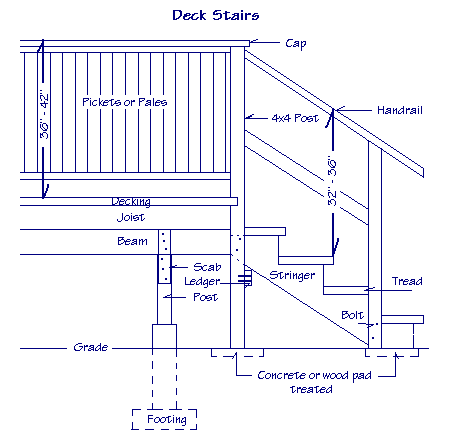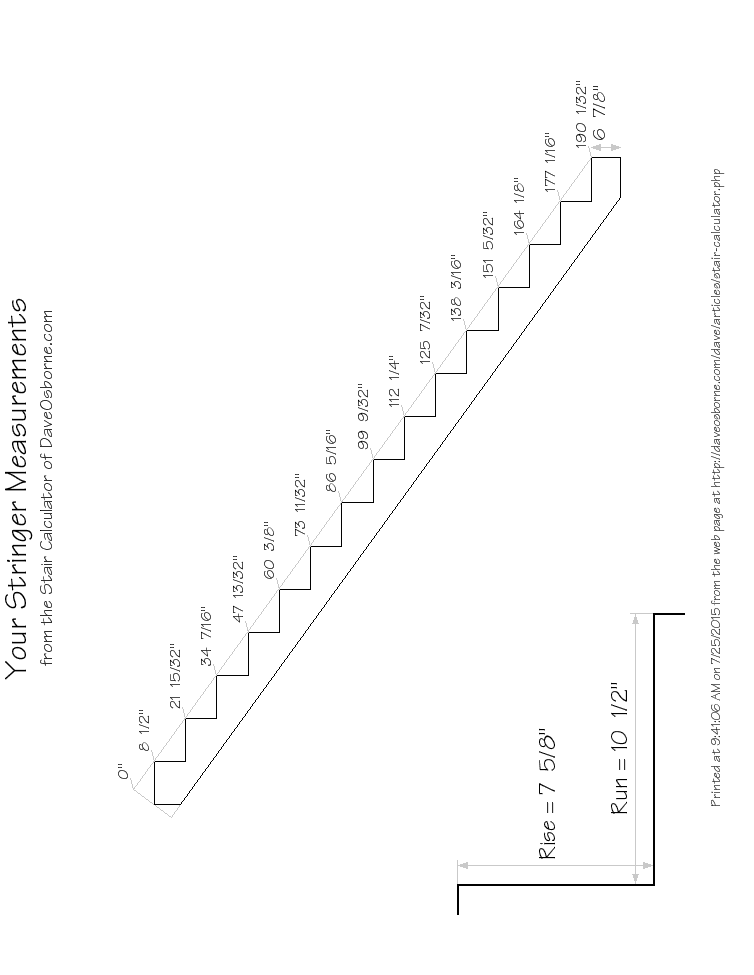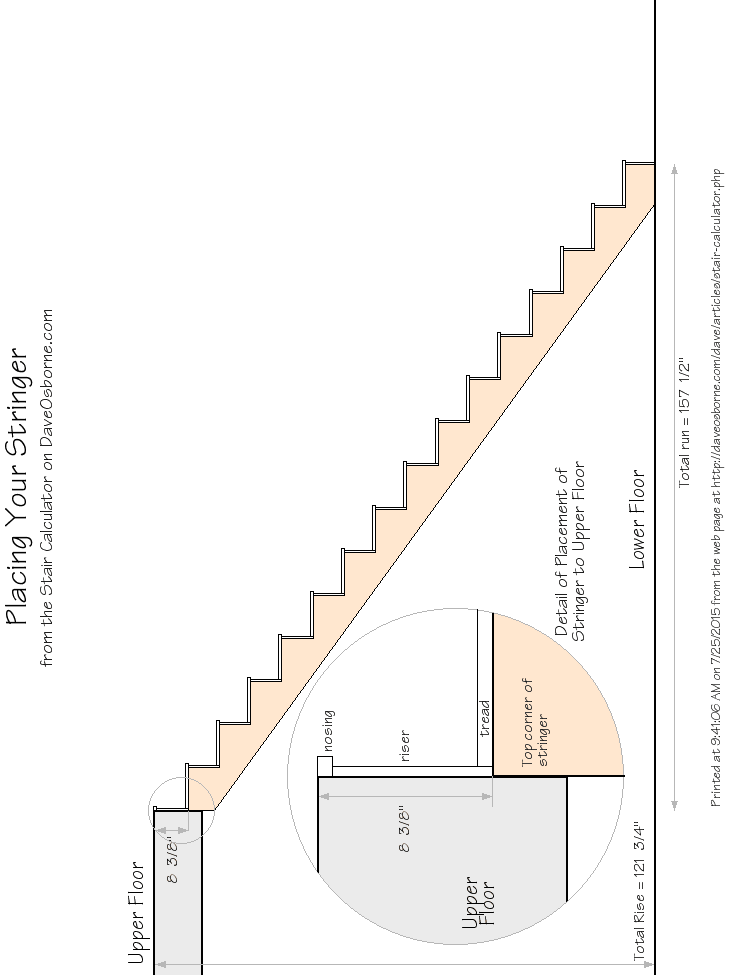
Building Confidence
| Volume 13 Issue 7 ISSN 1923-7162 |

Welcome to Dave's Shop Talk's Home Improvement Newsletter of questions from our members on their construction projects, a Tip of the Month and a home remodeling article, both from our website at http://daveosborne.com.
What's New
Be sure to check out our ebooks! We have finished 6 of the 10 eBooks in our Building Confidence series and are being told how helpful they are to do it yourselfers! Let your friends know about them!
Tip of the Month
To secure the bottom of a stair stringer to a concrete floor or sidewalk, install screws and anchors into the concrete through a 2x4 between the stringers.
And a Bonus Tip:
New plastic laminate can be glued down to an existing laminate counter top. Rough up the existing top and proceed as usual.
Ask Dave!
Hi Dave, For my outside stair rebuild, I will be attaching the stringers to my 2 x 10 deck rim board. Because I will need a total of 14 treads, I will need to drop the top of the stringer below the top of the deck. That will mean I will be attaching the stringers to the bottom 3" of the 2 x 10. I plan to use Simpson Strong-Tie stringer connectors. Will that be sufficient, or is there a better way to attach the stringers? I appreciate your advice. Thanks.
I prefer to support a long set of stringers, like this, from the ground up. Don't rely on support just with nails alone. Use the Simpson ties to position and hold the stringers and then support them as shown in these two diagrams:

This drawing shows support of the stringer with a 4x4 outside the stringer with a 2x4 ledger board nailed on below the stringer. This serves two purposes: to support the handrail as well as support the stringer. The 4x4s are attached to the stringer with 3/8" carriage bolts. This is explained in more detail on our website: http://daveosborne.com/dave/articles/how-build-stairs.php

This drawing shows support of a long stringer with 2x4 posts under each stringer on both sides. Instead of the Simpson ties you could use plywood, as shown. The plywood idea is mostly for inside stringers, though, since plywood tends to delaminate when exposed to the weather, over time. Notice the 2x4 plate at the bottom of the stringers. This would be nailed into the wooden or concrete floor. What would be good in your case with a long stringer is to combine both drawings. Put the 4x4 posts on a concrete or pressure treated wood pad on the ground to support the handrails. Then fasten a 2x4 post to the 4x4 under the stringer. The support like this really takes the bounce out of the center of the stairs, as well as giving good structural support at the top and middle of the stairs.
Dave
Dave, Im building a small cabin and using lp smartside. It is roughly 3/10s of an inch thick. I have sided the front of the build as of this point. My doors are going to be delivered on Friday. My question is this: Did I go too far when I sided before installing the door? I was told by my supplier to side before I put in the pre hung steel door. Will it matter? Thanks, Tracy
Hi Tracy,
With a prehung door, we apply the siding after the door is in. We sheet around the opening, then install the jamb and door and side to the trim on the jamb. The jamb of an outside prehung unit usually has a brick mold installed. This goes against the sheeting and the siding goes tight against the brick mold.
The supplier should know what he is talking about. I wouldn't change anything until you get the door and see for yourself.
Dave
Good Day Dave.
I have a question about stairs. My total rise is 121 3/4. On your stair calculator is the last step stepping on to the upper floor? Also I would like Hardwood stairs but I would like to put 3/4 ply on there until almost finished then attach hardwood treads. Hardwood treads are 5/8" so should I subtract 3/4" + 5/8" from bottom tread? Thank You for your help.
Yes, the last step is the one below the upper floor.
It depends on the upper and lower floors. If they will be covered with hardwood, then don't allow for hardwood on the stairs. Calculate the total rise from the upper sub-floor to the lower sub-floor and deduct only the thickness of the 3/4".
If the hardwood is already on the upper and lower floors. measure the total rise to the upper and lower finished floor and subtract 3/4" and 5/8" off the bottom of the stringer. Mount the top of the stringer 3/4" plus 5/8" down from the finished floor.
Just a note. When you put the 3/4 on the stair treads, don't have an overhang to form a nosing. The nosing will come with the hardwood treads. Cut the 3/4 treads flush with the riser, below it.
Dave
Dave the top floor is Carpet. The lower floor is Hardwood. So I can figure that out. I tried to use your calculator on your website but could not. I did end up using the one that you can't download. The height from subfloor to subfloor is 121 3/4. Could you use your calculator and email me a copy. Thank you.
Since the upper and lower floor measurements are to the sub-floors, we don't need to worry about their finishes since carpet and hardwood are about the same thickness as the hardwood on the steps, as well. The 3/4" on the stairs would act as a sub-floor with the 5/8" hardwood attached to it, as is or will be the same as the carpet on the upper floor and the hardwood on the lower floor.
Here are the calculations and drawings from the Stair Calculator:
Stair Measurements
from Dave's Easy Stair Calculator
at DaveOsborne.com
Total Rise entered: 121.75 inches
Floor Thickness: not entered
Number of rises: 16 rises Number of runs: 15 runs
Height of each rise: 7 5/8 inches Length of each run: 10 1/2 inches
Total Run: 157 1/2 inches (13'-1 1/2")
Length of board needed for the stringer: 18 feet
Length of opening in upper floor: needs Floor Thickness
Tape measurements (in inches) for the stringer (see diagram):
Copyright © 2015 by David E. Osborne. All Rights Reserved.
Floor Thickness: not entered
Number of rises: 16 rises Number of runs: 15 runs
Height of each rise: 7 5/8 inches Length of each run: 10 1/2 inches
Total Run: 157 1/2 inches (13'-1 1/2")
Length of board needed for the stringer: 18 feet
Length of opening in upper floor: needs Floor Thickness
Tape measurements (in inches) for the stringer (see diagram):
| 8 1/2 | 21 15/32 | 34 7/16 | 47 13/32 | 60 3/8 | 73 11/32 |
| 86 5/16 | 99 9/32 | 112 1/4 | 125 7/32 | 138 3/16 | 151 5/32 |
| 164 1/8 | 177 1/16 | 190 1/32 |


Hope this helps,
Dave
Thanks Dave this should work fine. Also I'm using decking boards for the runs 5/4 x 6. Will they work on a 36" span for the steps or do I need thicker runs?
Michael 'your a great help'
Hi Michael,
Even with a 2x6 - 1 1/2" thickness, I would put in a center stringer. 36" is bit too wide!
Dave
I'm replacing my stairs. I have a 56" rise to top of deck and I need to land 58" from deck to keep 3' from fence. Can you help on this?
Since your run is a bit short, we need to play with the numbers. To get drawings for your stringer, we can manipulate the stair calculator.
Enter 56 for total rise; 7 for rise and 8.29 for run and click Calculate.
Let me know if this works for you, or I can send the drawings by email. I would use a 3/4" or 1" nosing to widen the tread a bit. This cuts into your 3' space at the bottom, but you will still be according to code.
Dave
Hi Dave, I'm about to start hanging the joist for this deck. The first one is the outside joist and is hung with a hanger but this forces me to place the joist inside the end of the ledger board. This joist and the next one will be the support for the post that will support the railing. Will this be ok? Is there another way to hang the last joist that lines up with the end of the ledger board?
Yes, I usually just bend the tang over the end of the ledger and nail it in that way. You can cover it up later with a piece of siding or fascia board, etc.
Dave
Thanks Dave,
I had a thought about bending over the joist hanger but had never done it so I wanted to make sure it was doable. Thank you for confirming this, makes my layout a lot easier. Makes me happy I joined your group!
Emmett
Thanks, Emmett, I appreciate your nice comments.
Dave
Can you advise what I can use to take a small stain of purple PVC primer off a Delta fiberglass shower?
Sorry, that's a tough one. I would contact the Delta people and see what they say.
Dave
Can you advise if a 8KW generator (run on natural gas) will supply the electrical power for a 800 sq ft apartment that has NO electric hot water heater, stove or dryer? A friend has a portable 5KW that runs enough electricity for his 3000 sq ft house.
Hi Jim,
8000 watts is a good generator. Most appliances like toaster, hot plate, hair dryer, etc usually take about 1500 to 1800 watts on 110 volts. I don't see a problem, just make sure not more than 4 of those higher amp appliances are on at the same time. For lighting use the CFL or LED bulbs, which really cut down on power.
Dave
Feature Article of the Month
(taken from our website: DaveOsborne.com
Plumbing and Ventilation 2: How to Remove and Replace Plumbing Fixtures
There are times in home improvement when the home owner must replace a plumbing fixture or at least remove it. I'm referring to removing the toilet, removing the bathtub and sink faucets or just removing a valve stem to replace its washer.
Home Improvement: Removing The Toilet
Let's start with removing the toilet, which should be removed if the toilet leaks at the floor (it's possibly the wax seal) or if the toilet is plugged and the pipes need cleaning with a snake or you are replacing the flooring in the bathroom with tile, vinyl, hardwood, etc.
Ever wonder why there are so many names for our favorite plumbing fixture? When removing any plumbing fixture, first turn off the water. The commode (from the Southern US) should have its own shut off down near the floor, offset to the left of center. This shut off should be equipped with a 3/8" OD (outside diameter) compression fitting for a 3/8" supply tube or closet riser (from "water closet", UK). Most modern heads (toilet) are designed for this size riser. If the one you have is an old 1/2" OD riser and shut off, better change it. For 1/2" nominal copper pipe coming out of the wall, I prefer a... Read more at Plumbing and Ventilation 2: How to Remove and Replace Plumbing Fixtures.
Almost the End
Hope you enjoy the Newsletter this month.
We BUILD CONFIDENCE. If you need advice on your projects at work or home, please become a member of our website, then send me a question via email.
Check out our website! http://daveosborne.com
Please tell your friends and family about our site!
Your source for building tips, woodworking & furniture plans, house plans and building advice directly from Dave...
Hi, I'm Dave Osborne. With over 50 years experience as a journeyman carpenter, foreman and contractor in heavy construction I enjoyed working with apprentices and sharing the tricks of the trade that others shared with me. Now I get emails from Members all over the world and we include many of my answers in our Free Monthly Newsletters. Some of my answers include drawings and instructions specific to a project, but may also answer your questions. I use correct construction terminology, so you can confidently inform your building supply dealers or contractors exactly what you need.
ASK DAVE!
The Benefits of Membership
Membership gives you full access to our hundreds of how-to articles, woodworking plans, converters, calculators and tables. Our Stair Calculator is one of the most popular on the internet. We have projects you can build for (and with) your kids, furniture for your wife, and sheds and gazebos. If you run into a problem or need advice your Membership includes unlimited email questions to me through our Ask Dave quick response button.
Join us!
Copyright © 1999-2024 DDFM Enterprises. All Rights Reserved. DDFM ENTERPRISES, DAVE'S SHOP TALK and the Dave Osborne logo are trademarks and service marks owned by DDFM Enterprises. All other trademarks on this site are the property of their respective owners. Site design by Design Strategies, Inc.